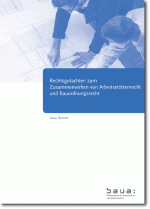A legal opinion clarifies the interaction between workplace law and building regulations.
Construction requirements for workplaces are primarily defined by workplace law (Arbeitsstättenrecht) and the law laid down in building regulations (Bauordnungsrecht). At first glance, there are intersections as well as contradictions between these two bodies of law. Such contradictions have to be resolved during the building planning process.
The planning of workplaces and implementation of workplace law sometimes bring conflicts to light between the requirements of workplace law and building regulations. These may concern railing heights and guard rails, escape routes, ceiling heights, and barrier-free workplaces, for example.
A legal opinion on this issue was commissioned by the Federal Institute for Occupational Safety and Health (Bundesanstalt für Arbeitsschutz und Arbeitsmedizin, BAuA) and prepared by the Halle Centre for Social Research (Zentrum für Sozialforschung Halle e.V.) at the Martin Luther University Halle-Wittenberg under the direction of Prof. Wolfhard Kohte.
This legal opinion explores the relationships between workplace law and building regulations. In particular, the intersections between these two regulatory fields are identified and assessed, and actually or supposedly contradictory requirements highlighted.
The legal report demonstrates in detail that there are no contradictions at the level of substantive law and that the requirements are strict when it comes to matters of hazard protection. The Technical Rules for Workplaces (Arbeitsstättenregeln, ASRs) and other technical regulations have to be interpreted in conformity with substantive law and EU law. As long as these categories are adequately explained, they provide a clear framework for practical solutions. The legal opinion’s conclusions are grouped by topic and presented in a form that makes them easy to implement in practice.
When workplaces are planned, it is necessary to take steps well in advance to ascertain what requirements are stipulated by workplace law and obtain recommendations from occupational health experts, then ensure these requirements and recommendations are given due consideration. Those requirements stipulated by workplace law and building regulations that are more far-reaching take precedence. “More far-reaching” is in this case to be interpreted as providing a higher degree of protection to employees.
In order to resolve the problems faced when implementing the current legal requirements, the Committee for Workplaces (Ausschuss für Arbeitsstätten, ASTA) has established a project group that will engage in expert dialogue with the Standing Conference of Federal State Ministers for Urban Development, Building and Housing (Bauministerkonferenz, ARGEBAU) and draw up proposals for action.
